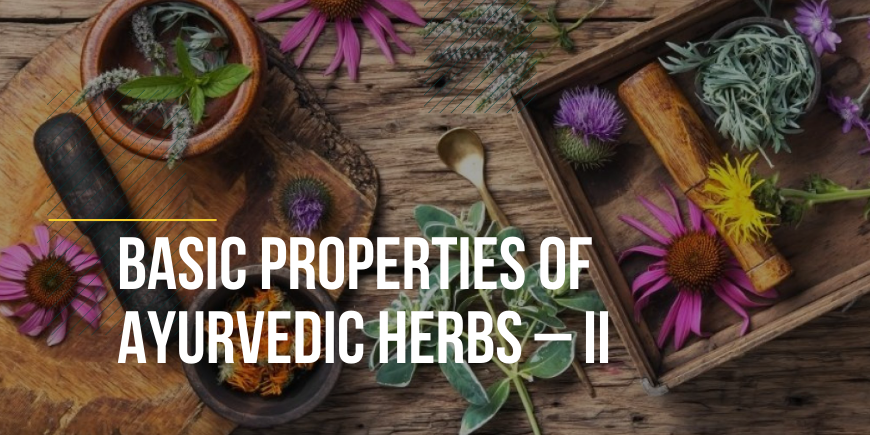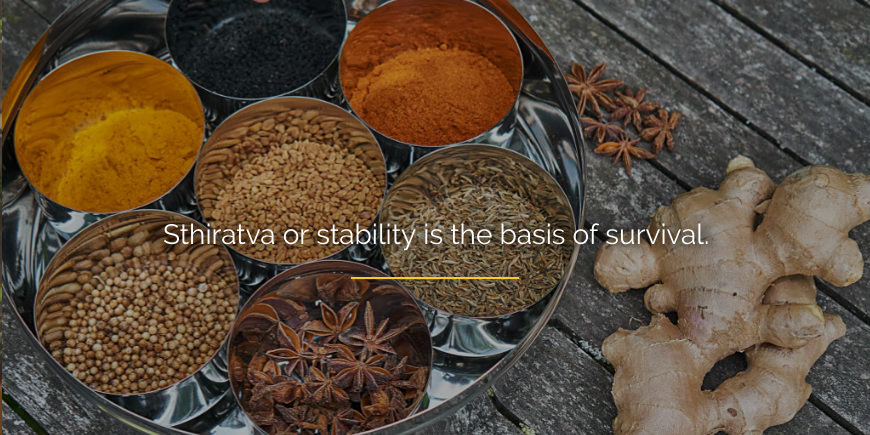
In the previous blog, we looked at the definition of padarth (entity), dravya (substance), types of dravya, and the guna or properties of substances, up to Ruksha (dry).
Gunas (Metabolic Properties)
1 | Guru | Heavy | Laghu | Light |
2 | Sheet | Cold | Ushna | Hot |
3 | Snigdha | Moist/Unctuous | Ruksha | Dry |
4 | Mand | Dull | Tikshna | Sharp |
5 | Sthir | Stable | Sar | Mobile |
6 | Mrudu | Soft | Kathin | Hard |
7 | Vishad | Clear | Pichchil | Slimy/viscous |
8 | Shlakshn | Smooth | Khar | Rough |
9 | Sukshm | Fine/Subtle | Sthul | Bulky |
10 | Sandra | Solid | Drav | Fluid |
In this blog, let us discuss more about the gurvadiguna.
Mand (Slow)
Mandatva or slowness is the basis of growth and rejuvenation in the body. This property is the basis for anabolic (building up) processes in the body.
Our body is a complex dynamic system. There is a fixed optimal rate for all metabolic processes. Mandatva (slowness) and Tikshnatva (sharpness) are like the keys on a DJ mixer. The body can adjust all these keys of gurvadiguna to balance itself.
There are two types of nervous systems in the body – sympathetic (emergency response mode/fight-flight-freeze system) and parasympathetic (rest and repair/feed and breed mode).
The parasympathetic nervous system employs the property of slowness. It slows down the body’s metabolism to an optimal level, leads to natural relaxation and repair. Growth also occurs when the body is relaxed. That’s why we can relate sleep hormone melatonin with slowness.
Various other minor processes like the accretion of stones inside the body are also related to slowness.
Few herbs cause slowness in the body. Normally, nervous relaxants or sedatives like Sarpagandha, Jatamansi, etc. can slow down the body’s metabolism. Guduchi, one great healing supplement works to relax the body and enable
Tikshna (Sharp/Fast Acting)
Tikshnatva or Sharpness/Speed is the opposing and balancing property to slowness. The sympathetic nervous system works with speed. It is the emergency mode that helps to protect the body during dangerous conditions. And the speedy reaction is a crucial factor for effective protection.
Speed is also deeply linked to hormonal or enzymatic action. Hormones can spread throughout the body within milliseconds and produce a profound effect. The Adrenaline hormone or the emergency hormone helps to increase the overall rate of metabolism and redirects the blood supply towards muscles, to enable running or fighting in emergency conditions!
Cognitive enhancing foods like coffee, tea, sugar, or herbs like Brahmi, Shankhpushpi, etc. help to improve the nervous response rate.
Summary
Mand (slow) and Tikshna (sharp) are two contrasting properties that balance each other in our dynamic metabolism. Slowness is the basis of accretion, growth, and development. It is a feature of the parasympathetic nervous system (rest and repair). Whereas sympathetic nervus system (fight-fright-freeze) promotes Tikshna (sharp) activity
Sthir (Stable)
Sthiratva or stability is the basis of survival. This property refers to inertia or status quo, it can be the static inertia.
Stability is the property that leads to the formation of bones and all the stabilizing structures in the body. We can compare the cellular endurance against damage, aging, or inflammation with Sthiravta. The stability of cells against all the deteriorating factors is a property that preserves the body and prevents aging and death.
In another aspect, homeostasis, or the natural biorhythm of various metabolic functions is a result of Sthiravta. It leads to perseverance and regularity in the body’s physiology. Stability is the property that
However, our body is a dynamic system, therefore too much stability can turn into metabolic inflexibility, and thus result in disorders. For example, constipation, or tumor formation inside the body is a function of an excess of stability.

Sar (Mobile)
Saratva or mobility is a crucial property that helps in all kinds of movements inside the body, esp. the transportation of nutrition and waste throughout the body.
In Ayurveda, the word Sar means a substance that leads to mobility. Blood is the body constituent with the highest mobility. Other substances with mobility are lymph, sweat, tears, etc. The entire process of excretion happens due to Saratva. And that is only the involuntary functions we have talked about. Voluntary functions like movement of body parts, swallowing, sneezing, etc. all are related to mobility.
Like stability, excess mobility also can cause problems. For example, abnormal intestinal movement can lead to loose motions. Nervine hyperactivity can result in mental disorders.
Summary
Sthiratva or stability is the foundation for cellular resistance and longevity, whereas Sar or mobility is the tool for transportation inside and outside the body. Major metabolic functions like respiration, excretion, etc. happen due to mobility.
Mrudu (Soft)
Softness is the quality that harbors flexibility and life in the body. All the vital soft tissues present inside the body survive because they are soft. The blood cells are flexible and soft, that’s why they can squeeze into finer blood vessels. The white blood cells change their shape and engulf the pathogens because of their soft flexible bodies.
The soft muscles, ligaments, and tendons bend and enable locomotion. The entire alimentary canal moves the food with peristaltic movement. All organs inside the body, whether it is the kidneys or the lungs, perform their functions because they are soft.
However, too much softness can lead to functional impairment. All kinds of hernias result when the supporting ligaments lose their firmness. Too much mucus (softness) in the respiratory system leads to breathing problems. All inflamed tissues become soft and vulnerable to pathogens.
Kathin (Hard)
This property leads to the formation of hard structures or hardening of body tissues. Hardness brings durability to the body parts. It is the primary contributing factor for the formation of bones, tendons, ligaments, etc.
Ayurveda says that one dhatu forms from the previous dhatu. Bones emerge from the metabolism of the meda or the adipose tissue. According to Ayurveda, the adipose tissue hardens to form bones. The bony tissue matures to form the bone marrow, which is soft tissue. In this way, there is no single permanent hard entity in the body, but the property of hardness passes from one cell to the other.
Abnormal hardness is a problem. For example, tumor formation in the body is a result of excess hardening. Similarly, atherosclerosis is a result of cholesterol accumulation and the gradual hardening of blood vessels. So, hardness is present as a transient or persistent property (e.g bones) in the body.
Summary
Mrudu (soft) tissues are alive. Softness sustains flexibility, moisture, and nourishment. Most rapidly multiplying tissues are soft. However, the contrasting property – hardness is equally important. The bones, tendons, and ligaments form the basis for structure and locomotion due to their hardness.
Take Away
The above mentioned are a few of the numerous examples one can find in the mind-blowing complexity of our metabolism. Ayurveda talks about the simplest abstract forces that shape our universe. Gurvadigunas are one of the multiple examples of such abstract Vedic concepts.
I hope that you benefit from this information. In the next blog, let us discuss more properties like Vishad (Clear), Pichchal (Slimy), Shlakshan (Smooth), Khar (Rough), Sukshm (Subtle), Sthul (Bulky), Sandra (Solid), and Dravya (Fluid).
Discover the power of Ayurveda and revolutionize your approach to health with our Ayurveda Certification Course! Learn from experts in the field as they guide you through the ancient Principles of Ayurveda. Master the art of personalized healing and make a lasting impact on the lives of others. Enroll now and embark on a fulfilling path of holistic wellness.

Responses